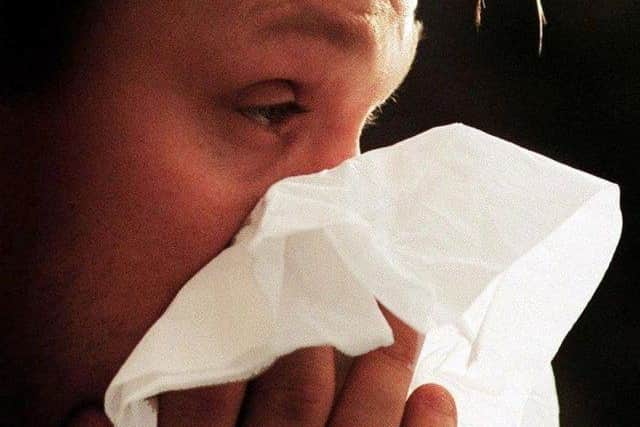Flu virus activity lower than two years ago but Influenza A and B strains are in circulation
and live on Freeview channel 276
Forty-nine positive samples for flu - including strains of H1N1 (a cousin of the Spanish flu and 2009 swine flu that is now an endemic strain of the virus) and H3 (a relation of the Hong Kong flu of 1968 which is also commonly in circulation in winter in Derry) - were picked up in the two weeks October 4 - 17 by health surveillance systems.
According to the first Public Health Agency flu bulletin of the season, "GP flu/flu-like-illness (FLI) consultation rates were 1.5 per 100,000 population in week 40 and 2.2 per 100,000 in week 41, which is lower than the same time in 2019/20 (2.2 vs 4.8 per 100,000 in week 41).
Advertisement
Hide AdAdvertisement
Hide Ad"This remains below the baseline threshold for the north (<11.3 per 100,000)."


This means flu activity is officially considered to be low.
"Flu/ FLI consultation rates were highest in 65+ year olds in week 40 and 45- 64 year olds in week 41 (3.5 and 3.3 per 100,000, respectively).
"Rates are lower in all age groups, except 0-4 year olds, compared to the same time in 2019/20 (Week 41)," according to the PHA update.
Out-of-hours flu consultations
Out of hour consultations were also lower than this time two years ago.
Advertisement
Hide AdAdvertisement
Hide Ad"Flu/FLI consultation rates in Primary Care Out-of-Hours (OOH) Centres were 2.6 per 100,000 population in week 40 and 1.8 per 100,000 in week 41. This is lower than the same time in 2019-20 (2.6 per 100,000 in week 41)," the PHA reports.
However, the number of people ringing up OOH is roughly the same as it was at the start of the winter prior to the COVID-19 pandemic.
"In weeks 40 and 41 the percentage of calls to an OOH Centre due to flu/FLI was 0.4% and 0.3%, respectively. This is relatively similar when compared to the same period in 2019-20 (0.5% in week 41). Rates were highest in those aged 0-4 years in weeks 40 and 41 (9.0 and 3.6 per 100,000 population, respectively).
"In comparison to week 41, 2019- 20, consultation rates were lower in all age groups, except 5-14 and 65+ years," the bulletin states.
Samples tested and proportion positive
Advertisement
Hide AdAdvertisement
Hide AdThough flu activity is lower than it was two years ago several strains of the virus are known to be in circulation.
"Prior to the beginning of the 2021-22 flu season (week 40, 2021) four samples tested positive for flu in weeks 36 to 39, 2021 (2 Flu A(H3) and 2 Flu B). In weeks 40 and 41, 49 samples were positive for flu (11 Flu A(H3), 3 Flu A(H1N1), 9 Flu A (untyped), and 26 Flu B) from 11,360 submitted for testing in laboratories across Northern Ireland.
"Positivity for weeks 40 and 41 combined (0.4%) is lower when compared to this time in 2019-20 (3.1%). The majority (87.8%) of total influenza positive samples since week 40 occurred in children aged 0-14 years," the PHA says.
The bulletin says these results should be interpreted with caution because vaccine contamination can occur when vaccine virus is detected in a specimen taken from a person (e.g. a child under 16 years) who recently received intranasal administration of live attenuated influenza virus vaccine (LAIV).
ICU and outbreaks
Advertisement
Hide AdAdvertisement
Hide AdNo ICU flu admissions or outbreaks were reported over the fortnight.
The document states: "There were no new admissions to ICU with confirmed influenza reported to the PHA in weeks 40 and 41 (Figure 7). Summary information on cases will be reported in the bulletin only if the numbers do not risk data confidentiality.
"During weeks 40 and 41 there were no confirmed influenza outbreaks reported to the PHA Health Protection acute response duty room."
Deaths
The bulletin reports that the trend in terms of respiratory deaths is roughly the same as it was in 2019/20 with no excess mortality reported.
Advertisement
Hide AdAdvertisement
Hide Ad"The Northern Ireland Statistics and Research Agency (NISRA) provide the weekly number of respiratory associated deaths and its proportion of all– cause registered deaths. Respiratory associated deaths include those that are attributable to influenza, other respiratory infections or their complications.
"This includes 'bronchiolitis, bronchitis, influenza or pneumonia' keywords recorded on the death certificate. Please note, NISRA mortality data is not the same as the actual number of deaths during the reporting period.
"In week 40, 77 respiratory associated deaths out of 330 all-cause deaths were reported (23%), with 29% in week 41. These trends are broadly the same as the same period in 2019/20.
"There was no excess all-cause mortality reported in Northern Ireland in weeks 40 and 41," the bulletin states.
Advertisement
Hide AdAdvertisement
Hide AdThe PHA points out that the annual winter rise in mortality is the result of a range of influences including flu.
"There is no single cause of ‘additional’ deaths in the winter months but they are often attributed in part to cold weather (e.g. directly from falls, fractures, road traffic accidents), through worsening of chronic medical conditions e.g. heart and respiratory complaints and through respiratory infections including influenza," the bulletin states.
Comment Guidelines
National World encourages reader discussion on our stories. User feedback, insights and back-and-forth exchanges add a rich layer of context to reporting. Please review our Community Guidelines before commenting.